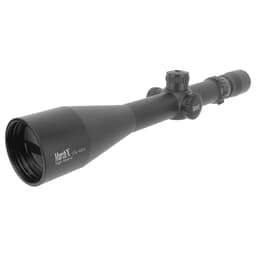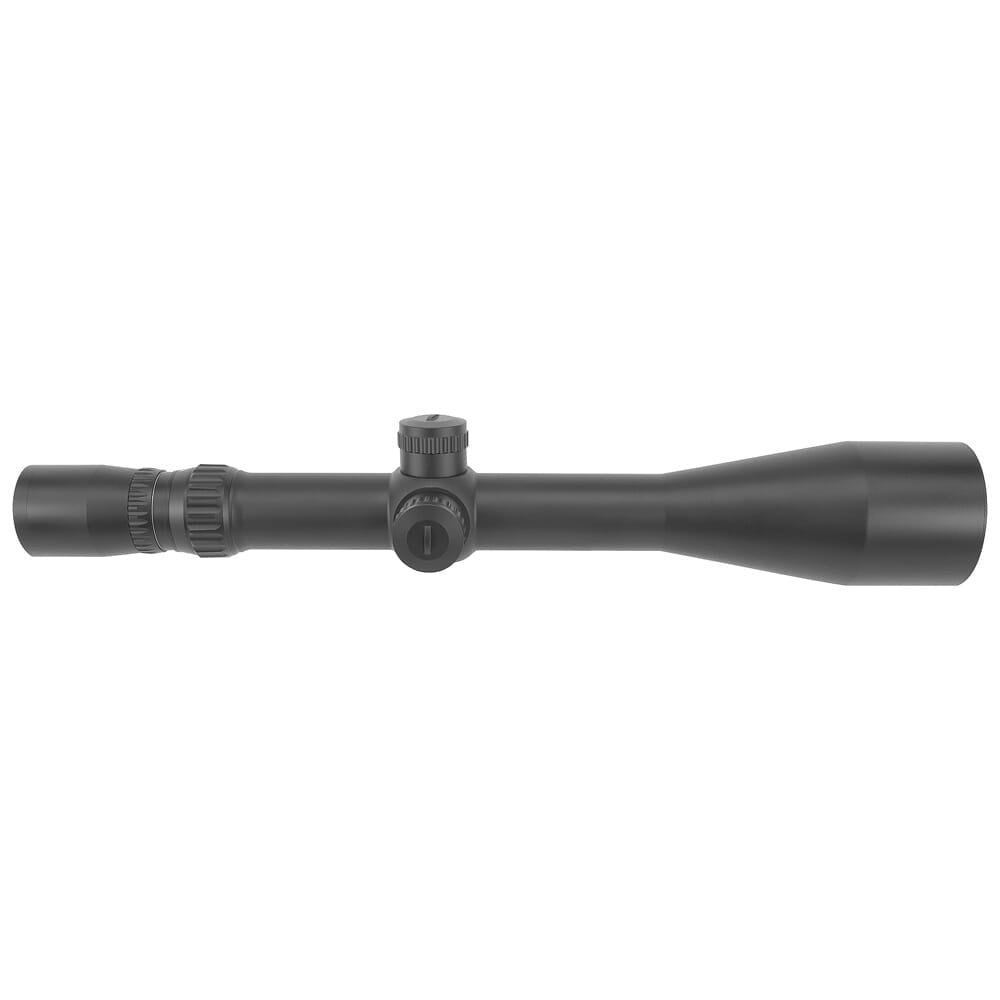Description
March High Master 10-60x56 CH Reticle Riflescope delivers high-resolution imaging through its Super ED and Hi Refractive Lenses. The 10x to 60x variable magnification range allows for clear target acquisition across diverse shooting distances. Equipped with a second focal plane reticle, this scope ensures that the reticle's size remains constant, providing precise aiming at any magnification level. Capped turrets facilitate easy adjustments, making on-the-fly corrections straightforward and reliable.
Weighing 32.6 oz. and featuring a robust 34mm tube, the riflescope is built for durability and performance in various environments. Its ergonomic design enhances comfort during extended periods of use, and the generous eye relief of 85-101mm allows for comfortable viewing without eye strain. This riflescope is ideal for competitive shooting, long-range hunting, and tactical applications.
Features – Key Benefits Bullets
- SUPER ED LENSES for enhanced light transmission and clarity in low-light conditions.
- VARIABLE MAGNIFICATION from 10x to 60x for versatile shooting scenarios.
- SECOND FOCAL PLANE RETICLE maintains consistent reticle size, ensuring accuracy at all distances.
- CAP TURRRETS for easy and reliable adjustments during shooting.
- ERGONOMIC DESIGN provides comfort during extended use, reducing fatigue.
- 85-101MM EYE RELIEF allows for comfortable viewing and reduces the chance of scope bite.
- 34MM TUBE DIAMETER enhances durability and improves optical performance.
- LIGHTWEIGHT CONSTRUCTION at 32.6 oz. for ease of handling without sacrificing stability.
Technical Specifications
| Specification | Details |
|---|---|
| Magnification | 10-60x |
| Objective Lens Diameter | 56mm |
| Tube Diameter | 34mm |
| Weight | 32.6 oz. |
| Eye Relief | 85-101mm |
| Field of View | 10.2 ft - 1.7 ft @ 100 yd |
| Parallax Adjustment | 40 MOA |
| Turret Adjustment Click Value | 1/8 MOA |
What's in the Box?
- Sunshade
- Flip Caps
- Fast Lever
- MD Disk
Customer Reviews
"Exceptional clarity and brightness, even in low light. Perfect for my competition shooting!"
"The adjustments are precise, and the ergonomics make it comfortable for long sessions at the range."
FAQ
How does the March High Master handle recoil? The robust construction is designed to absorb recoil effectively, making it suitable for high-caliber rifles.
Is the riflescope waterproof and fog-proof? Yes, it is nitrogen purged and O-ring sealed to ensure reliable performance in all weather conditions.
How does this scope compare to others in its class? With its advanced lens technology and variable magnification, it outperforms many competitors in terms of clarity and versatility.
What maintenance is required? Regular cleaning of the lenses and checking for any signs of wear on the turrets will help maintain optimal performance.
Can I use this scope for night shooting? While it excels in low-light conditions, it does not feature an illuminated reticle, so additional lighting may be needed for night shooting.
Similar Models
Explore our full collection of March optics to find models like March 4-24x52 for versatility or March 5-40x56 for precision long-range shooting. Each model is crafted for optimal performance and reliability in various shooting scenarios.
Our Guarantees
FREE Fast Shipping Over $99
Enjoy complimentary expedited shipping on all orders over $99.
Secure Payments
Shop with confidence using our encrypted payment processing.
High Quality or Money Back
Not satisfied with your purchase? We'll refund your money, no questions asked.
Top-Notch Support
Our expert team is available to answer all your questions and provide assistance.
What Our Customers Say
Optics Knowledge Center
Understanding Rifle Scope Basics
Magnification
Magnification refers to how much larger an object appears through the scope compared to the naked eye. Fixed power scopes have one magnification setting, while variable power scopes offer a range (e.g., 3-9x).
Objective Lens
The objective lens is the front lens that gathers light. Larger objective lenses (measured in mm) gather more light, providing brighter images in low-light conditions but add weight and require higher mounting.
Reticle
The reticle (crosshair) is the aiming point inside the scope. Modern scopes offer various reticle designs, from simple duplex crosshairs to complex ballistic reticles with holdover points for different distances.
Adjustments
Rifle scopes have turrets for windage (horizontal) and elevation (vertical) adjustments. These are measured in MOA (minutes of angle) or MRAD (milliradians) and allow precise aiming adjustments.
Proper Scope Mounting Guide
Select the Right Rings & Base
Choose rings that match your scope's tube diameter (typically 1", 30mm, or 34mm). Select a base compatible with your rifle's receiver. For heavy-recoiling rifles, opt for stronger mounts.
Install the Base
Clean the receiver and base thoroughly. Apply a small amount of blue Loctite to the screws. Attach the base to the receiver and torque the screws to manufacturer specifications.
Attach the Rings
Attach the bottom halves of the rings to the base. Place the scope in the rings and loosely attach the top halves. Don't fully tighten yet.
Set Eye Relief & Level
Position the scope for proper eye relief (3-4 inches) in your normal shooting position. Ensure the reticle is level using a scope leveling tool. Once positioned correctly, tighten the rings evenly in a cross-pattern.
Scope Zeroing Tips
Start Close
Begin zeroing at a shorter distance (25-50 yards) to ensure you're on paper before moving to your desired zero distance (typically 100 yards).
Use a Stable Rest
Always zero your rifle from a stable shooting position using a bench rest, sandbags, or a shooting rest to eliminate as much human error as possible.
Fire Groups
Fire 3-shot groups before making adjustments. This provides a more accurate representation of where your rifle is shooting than single shots.
Make Deliberate Adjustments
Know your scope's adjustment values (typically 1/4 MOA per click). If your group is 2 inches low at 100 yards, you'll need to adjust up 8 clicks (for a 1/4 MOA scope).
Confirm Your Zero
After making adjustments, fire another group to confirm your zero. Repeat the process until your point of impact matches your point of aim.
Document Your Settings
Once zeroed, record your settings including distance, ammunition used, and environmental conditions for future reference.
Optics Maintenance & Care
Cleaning Lenses
- Start by blowing or brushing away loose particles
- Use a lens pen or microfiber cloth for fingerprints
- For stubborn dirt, use lens cleaning solution (never household cleaners)
- Clean with gentle circular motions from center outward
Protecting Your Optics
- Always use lens caps when not in use
- Store in a dry place with silica gel packets
- Avoid extreme temperature changes
- Use a quality scope cover in harsh conditions
Regular Maintenance
- Check and tighten mount screws periodically
- Inspect O-rings and seals for damage
- Verify zero after rough handling
- Clean the exterior with a damp cloth
What to Avoid
- Never use fingers to touch lenses
- Avoid paper products (tissues, paper towels) on lenses
- Don't use acetone, alcohol, or household cleaners
- Never disassemble your scope (voids warranty)




